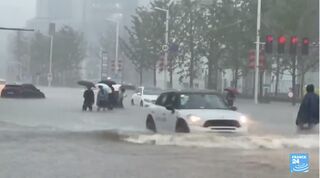Difference between revisions of "辶"
(→Use) |
|||
| Line 283: | Line 283: | ||
[[X9053]] [[道]] [[道]] <ref> |
[[X9053]] [[道]] [[道]] <ref> |
||
| + | https://www.nihongo-pro.com/kanji-pal/kanji/%E9%80%B2 |
||
道 |
道 |
||
12 strokes |
12 strokes |
||
Latest revision as of 04:38, 8 September 2021
X8FB6 辶 (Walk3) is Unicode character number 36790, KanjiRadical, WalkU
辶 uses 3 bytes: %e8%be%b6 ; 232 190 182 in the decimal representation.
辶 can be pronounced as Shinnyou, しんにょう and mean road, walk, to advance [1].
辶 appears as component of images of other kanjis.
辶 is is element of WalkU and is easy to confuse with other elements of this set.

WalkU
By definition, X8FB6 辶 belongs to set WalkU, that has five elements:
X2ECC ⻌ [2], KanjiRadical, Walk0, SIMPLIFIED WALK
X2ECD ⻍ [3], KanjiRadical, Walk1, WALK ONE
X2ECE ⻎ [4], KanjiRadical, Walk2, WALK TWO
X8FB6 辶 [5], KanjiLiberal, Walk3
XFA66 辶 [6], KanjiConfudal, Walk4
System of names (Walk0,Walk1,Walk2,Walk3,Walk4) is based on descriptions [3][4] of two of these characters by The Unicode Utilities.
These Kanjis are ordered their Unicode numbers. In analogy with characters WALK ONE and WALK TWO,
the next character in the list, it est, X8FB6 辶, is denoted with term WALK THREE, or, shorter,
Walk3; this word is easier to remember than the hexadecimal number X8FB6.
At the current representation of the Unicode characters in computers, the pic 辶 of the character cannot be used as its identifier, and more distinguishable names are necessary; for example, Walk0, Walk1, Walk2, Walk3 and Walk4.
At least in the range X0020-XFFFF, no other characters is found with similar pic to confuse with.
However, among Unicode characters whit higher numbers, in some implementation, another similar character may appear;
then, such a character can be denoted with symbol Walk5.
Characters of WalkU have similar pics; they have similar pronunciations しんにょう, Shinniou and similar meanings: walk, move, advance. This causes confusion.
Confusion
In century 21, the implementation of Japanese characters in computers in underdeveloped.
Up to year 2021, there is no united standard default font, that would allow each character to look the same at various computers, but different from other characters.
Practically, the opposite case takes pace:
View of some Unicode characters depends on the default font of the operational system,
while even within the same operational system, different characters may look just the same.
Such a confusion takes place in the case of character 辶 [7].
Not only Humans, but even the software confuse the characters.
The KanjiConfudal XFA66 辶 is often substituted with X8FB6 辶, silently, without any waring.
In particular, at the default setting of MediaWiki, it is not possible to create two independent articles with names 辶 and 辶;
an attempt to access 辶 redirects here.
Even a native Japanese speaker, watching characters
⻌,⻍,⻎,辶,辶
is unlikely to answer:
Which of them is X2ECC?
Which of them is X2ECD?
Which of them is X2ECE?
Which of them is X8FB6?
Which of them is XFA66?
In such a case, the correct specification of the character is
"X2ECC ⻌ or X2ECD ⻍ or X2ECD ⻎ or X8FB6 辶 or XFA66 辶"
Term WalkU is defined to substitute this (too long and too complicated) construction with single word.
Jisho
辶 4 strokes
Variants: 辵
walk, walking, road radical variant (no. 162)
On: チャク
Noun 1. kanji "road" or "advance" radical (radical 162) See also 之繞を掛ける
Other forms 之繞 【しんにゅう】、辶 【しんにょう】、辶 【しんにゅう】、辵 【しんにょう】、辵 【しんにゅう】、⻌ 【しんにょう】、⻌ 【しんにゅう】
辶 walk, walking, road radical variant (no. 162)
Use
In written Japanese languages of century 21, character 辶, by itself, is not popular.
The image of this character (or that of other WalkU) is used by the font designers to make pictures of other, more complicated and more usual, kanjis. Here are few examples:
X901A 通 通 [10]: Traffic, pass through, avenue, commute, counter for letters, notes, documents
X9023 連 連 [11]: Take along, lead, join, connect, party, gang, clique
X9032 進 進 [12]: continue, move on, Advance, proceed, progress, promote
X9053 道 道 [13]: Road-way, street, district, journey, course, moral, teachings
X9078 選 選 [14]: Elect, select, choose, prefer
The characters above are complicated; they are enlarged in order to allow the visual recognition.
(Over-vice, all of them would look similar to character X2592 ▒.)
Bue even after the endargmenr, it is difficult to say, namely which character of WalkU is used as prototype for the lower-bottom parts of the kanjis mentioned.
Meanings of WALK ONE seem to be just compillation of meanings of kanjis, whose images include image similar to ⻍.
More complicated Kanjis mentioned above seem to be more usual, more popular, than simple elements of WalkU; perhaps, due to the confusions mention.
Revealing and analysis of origin of these confusions could be topic for the scientific research.
⾡ and 辵
Character 辶 has synonyms, in addition to the WalkU.
Character X2FA1 ⾡ can be pronounced Shinnuu, しんにゅう and may mean "to enter", "road", "advance". It is qualified as Radical 162 [15].
Similar description refers to character X8FB5 辵; it also means "move". [16]
Characters
X2FA1 ⾡ and
X8FB5 辵
look similar; at Macintosh default font, the same picture seems to be used for both.
For this reason, each of these two characters is qualified as confuse;
they cannot be used in Tarja language.
However, the Romanji Sinnuu and Hiragana しんにゅう are allowed.
Each of this words can be pronounced "as is" and may mean "enter", "advance" or "road", "street".
Tarja
Due to the high ambiguity, none of the five characters of WalkJ is allowed in Tarja.
Character 辶 can be translated into Tarja in the following ways:
1. WalkU
2. Shinnyou
3. しんにょう
4. X8FB6 or Walk3 (if it is necessary to distinguish it from other WalkU).
None of this words look similar to other elements of the Tarja language.
Gallery
References
- ↑ https://kanjialive.com/214-traditional-kanji-radicals/ .. ⻌ にょう Radical which wraps around the bottom road, walk, to advance しんにょう a variant of ⾡(しんにょう) Important
- ↑ https://util.unicode.org/UnicodeJsps/character.jsp?a=2ECC ⻌ 2ECC CJK RADICAL SIMPLIFIED WALK Han Script id: allowed confuse: 辶 , 辶 , ⻍ ..
- ↑ 3.0 3.1 https://util.unicode.org/UnicodeJsps/character.jsp?a=2ECD ⻍ 2ECD CJK RADICAL WALK ONE Han Script id: allowed confuse: 辶 , 辶 , ⻌ ..
- ↑ 4.0 4.1 https://util.unicode.org/UnicodeJsps/character.jsp?a=2ECE ⻎ 2ECE CJK RADICAL WALK TWO Han Script id: allowed confuse: none ..
- ↑ https://util.unicode.org/UnicodeJsps/character.jsp?a=8FB6 辶 8FB6 CJK UNIFIED IDEOGRAPH-8FB6 Han Script id: restricted confuse: 辶 , ⻌ , ⻍ ..
- ↑ https://util.unicode.org/UnicodeJsps/character.jsp?a=FA66 辶 FA66 CJK COMPATIBILITY IDEOGRAPH-FA66 Han Script id: allowed confuse: 辶 , ⻌ , ⻍ ..
- ↑ https://en.wiktionary.org/wiki/辶 (Redirected from ⻌) See also: 辵 and 廴 .. Depending on the computer font used, this character may appear be to either ⻍, ⻎ or ⻌ .. The form ⻍ (two dots, four strokes) is the traditional form found in the Kangxi dictionary which is used in Japanese kyūjitai, Japanese hyōgai kanji, Korean hanja and Vietnamese Nôm.// The form ⻎ (one dot, four strokes, same as the animated stroke diagram) is the revised form for Traditional Chinese used in the Song typeface (宋體) in Taiwan, Hong Kong and Macau. This form is also the calligraphic form used in regular script (楷書) in all regions.// The form ⻌ (one dot, three strokes) is used in the Song typeface (宋體) in mainland China (based on Xin Zixing, 新字形) and the Ming typeface (明朝体) in Japan for jōyō kanji characters. A CJK compatibility ideograph exists at U+FA66 for the alternative Japanese form of this radical with only one dot and three strokes that is used for jōyō kanji characters.// // Han character// Commons-logo.svg See images of Radical 162 辶 辶 (radical 162, 辵+0, 4 strokes in traditional Chinese, Japanese and Korean, 3 strokes in simplified Chinese, cangjie input 戈弓弓人 (INNO) or X卜 (XY), four-corner 30300, composition ⿳丶𠃍乀(G) or ⿳⺀𠃍乀(JKV) or ⿳丶⿱㇇㇇乀(HT)) Kangxi radical #162, ⾡. Usage notes[edit] This character is not to be confused with the visually similar but unrelated 廴 (Radical 54).
- ↑ https://jisho.org/search/%E8%BE%B6%20%23kanji 辶 4 strokes Radical: walk 辵 (辶, ⻌, ⻍) Parts: Variants: 辵 walk, walking, road radical variant (no. 162) On: チャク
- ↑ https://jisho.org/search/%E8%BE%B6 Words — 1 found しんにょう 之繞 Links Noun 1. kanji "road" or "advance" radical (radical 162)See also 之繞を掛ける Other forms 之繞 【しんにゅう】、辶 【しんにょう】、辶 【しんにゅう】、辵 【しんにょう】、辵 【しんにゅう】、⻌ 【しんにょう】、⻌ 【しんにゅう】 Details ▸ Kanji — 1 found 4 strokes. 辶 walk, walking, road radical variant (no. 162) On: チャク
- ↑ https://www.nihongo-pro.com/kanji-pal/kanji/通 通 10 strokes READINGS KUN 訓 とおる とおり とおす とおし かよう ON 音 ツウ ツ STROKE ORDER Stop Pause Previous Stroke Next Stroke Slow Fast Animation data provided by KanjiVG Look up a kanji: Report an issue on this page JLPT Level: JLPT N4 (upper beginner level) Kanken Level: Kanken Level 9 (completion of 2nd grade) Grade: Taught during the 2nd grade in Japan Radical: ⻍(⻌) Radical name: しんにょう Meaning: Traffic, pass through, avenue, commute, counter for letters, notes, documents, etc.
- ↑ https://www.nihongo-pro.com/kanji-pal/kanji/連 JLPT Level: JLPT N3 (lower intermediate level) Kanken Level: Kanken Level 7 (completion of 4th grade) Grade: Taught during the 4th grade in Japan Radical: ⻍(⻌) Radical name: しんにょう Meaning: Take along, lead, join, connect, party, gang, clique Usage: Appears very frequently in Japanese newspapers; only about 30 kanji are used more often.
- ↑ https://www.nihongo-pro.com/kanji-pal/kanji/進 進 11 strokes READINGS KUN 訓 すすむ すすめる ON 音 シン STROKE ORDER Stop Pause Previous Stroke Next Stroke Slow Fast Animation data provided by KanjiVG Look up a kanji: Report an issue on this page JLPT Level: JLPT N3 (lower intermediate level) Kanken Level: Kanken Level 8 (completion of 3rd grade) Grade: Taught during the 3rd grade in Japan Radical: ⻍(⻌) Radical name: しんにょう Meaning: Advance, proceed, progress, promote Usage: Appears very frequently in Japanese newspapers; only about 150 kanji are used more often.
- ↑ https://www.nihongo-pro.com/kanji-pal/kanji/%E9%80%B2 道 12 strokes READINGS KUN 訓 みち ON 音 ドウ トウ STROKE ORDER Stop Pause Previous Stroke Next Stroke Slow Fast Animation data provided by KanjiVG Look up a kanji: Report an issue on this page JLPT Level: JLPT N4 (upper beginner level) Kanken Level: Kanken Level 9 (completion of 2nd grade) Grade: Taught during the 2nd grade in Japan Radical: ⻍(⻌) Radical name: しんにょう Meaning: Road-way, street, district, journey, course, moral, teachings Usage: Appears very frequently in Japanese newspapers; only about 200 kanji are used more often.
- ↑ https://www.nihongo-pro.com/kanji-pal/kanji/選 選 15 strokes JLPT Level: JLPT N3 (lower intermediate level) Kanken Level: Kanken Level 7 (completion of 4th grade) Grade: Taught during the 4th grade in Japan Radical: ⻍(⻌) Radical name: しんにょう Meaning: Elect, select, choose, prefer Usage: Appears very frequently in Japanese newspapers; only about 60 kanji are used more often.
- ↑ details. 辵 しんにゅう noun kanji "road" or "advance" radical (radical 162) (see also: 之繞を掛ける) (click the word to view an additional 1 reading and 3 forms, examples and links)
- ↑ https://www.kanshudo.com/kanji/辵 辵 means 'move' 辵Animation / stroke order not available. CHALLENGE DRAW Strokes : 7 Radical number: 162 Usefulness: 8 Intermediate lesson: - Beginner lesson: - Begins 0 words Used in 1 word Not used as a component Hyōgaiji (表外字) Additional readings On チャク Variants ⾡ (Chinese) ⻍ (Chinese) ⻎ (Chinese) 辶 ⻌






















